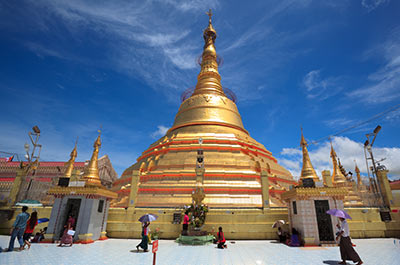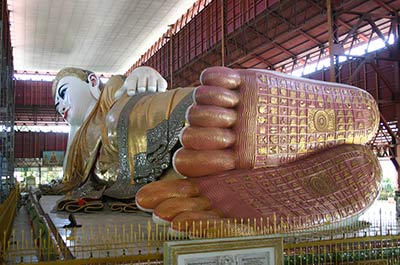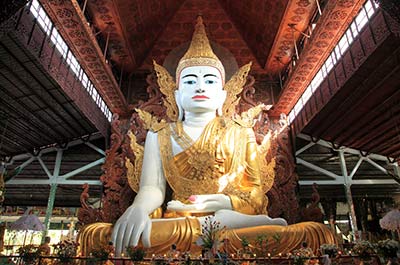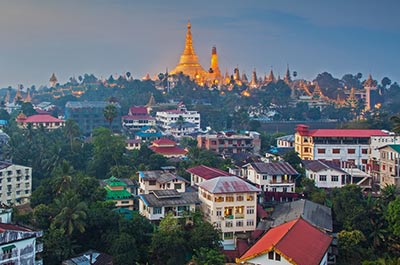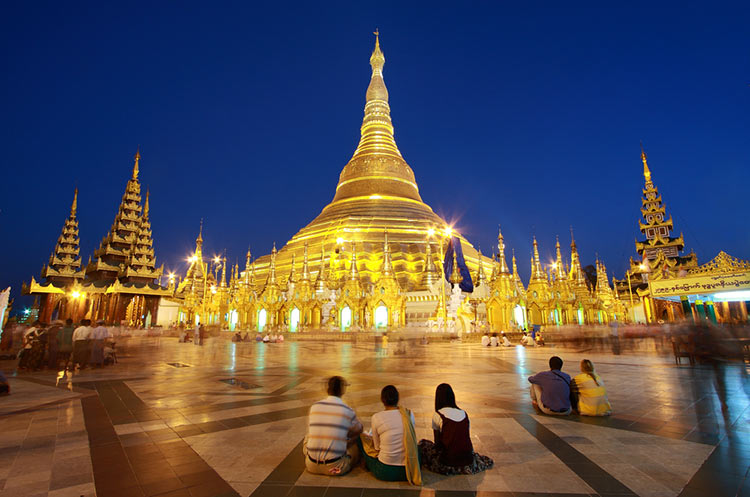
Shwedagon Pagoda
99 Meter tall gold plated stupa topped with diamond studded hti
The elegant Shwedagon pagoda is Yangon’s most famous landmark. The massive 99 meter high gold plated pagoda with the diamond studded spire set on top of a small hill in downtown Yangon dominates the area and is visible from much of the city. After dark there is a mystical atmosphere with the pagoda lit up by spotlights.
Burma’s most important Buddhist pilgrimage site
The very impressive pagoda, also known as the Golden pagoda, is Burma’s most important Buddhist pilgrimage site. The main stupa enshrines sacred relics of the Gautama Buddha as well as the three previous Buddhas.
History of the Shwedagon pagoda
According to legend the pagoda is more than 2,500 years old dating back to the lifetime of the Buddha, making it the oldest pagoda in Burma. Historical evidence suggests the pagoda was built by the Mon around the 6th century. Since then the pagoda has been enlarged and renovated many times, and numerous smaller stupas and other structures have been added.
The Sularata Nat that found the spot to build the pagoda
According to legend two merchant brothers from Okkalapa (present day Yangon) who lived about 2,500 years ago met the Buddha in India. The Buddha gave them eight of His hairs and told them to enshrine them in the same spot on a hill in Okkalapa where relics of the previous three reincarnations of the Buddha were buried.
The brothers returned to Okkalapa and presented the Buddha relics to their King, who started searching for the spot. After years of searching in vain a Nat spirit called Sularata decided to help the King. The Nat who was millions of years old hat witnessed the visits of the previous three Buddhas and remembered the spot on Singuttara hill where the relics were enshrined. It was at this spot that the Shwedagon pagoda was built.
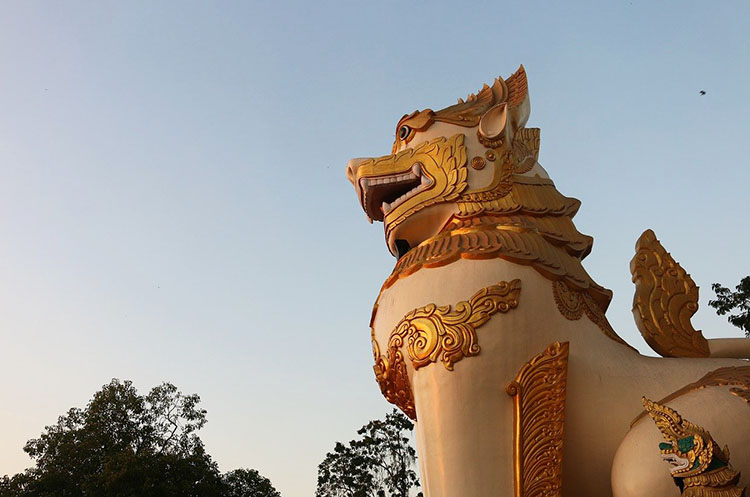
Four entrances guarded by Chinthes
There are four entrances to the complex, all of which except the Eastern one have either an escalator or an elevator. All are guarded by enormous Chinthes, Burmese mythological lions with a white body and golden colored head.
The upper part of the walls at the entrances to the complex are decorated with beautiful Burmese style depictions of the Jataka tales, the stories about the previous lives of the Buddha.
Center of the complex
The center of the large complex is formed by a large platform measuring 275 meters long with the main stupa and many smaller stupas surrounding it. The main stupa enshrines relics of the four previous Buddhas including sacred hair relics of the most recent Buddha.
Since the Shwedagon pagoda is the most sacred place for Buddhists in Burma, large numbers of devotees come to the Shwedagon every day. They walk around the stupa and make offerings to the Buddha.
At each corner of the octagonal pagoda is a shrine with a Buddha image (one for each day of the week, Wednesday is split into two). Every shrine has a planet and an animal sign associated with it in accordance with Eastern astrology. Burmese people pray to the shrine belonging to their day of birth burning candles, offering flowers and pouring water over the image.
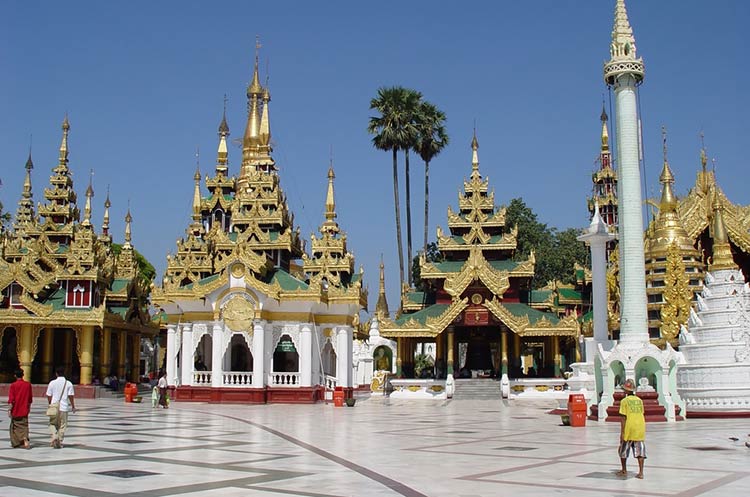
The gold plated main stupa with the diamond studded hti
The main stupa is the temple’s most impressive structure. It is visible at its hilltop location from much of Yangon city. The stupa is surrounded by 64 small stupas.
The 99 meters high main stupa is completely covered with gold plating and enshrines the sacred Buddha relics. Its core is solid and not open to the public.
A seven spired hti, an ornament shaped as an umbrella with golden bells attached to it is placed at the top of the pagoda. The hti is decorated with thousands of diamonds and other precious stones.
If you stand in the right spot of the pagoda platform, you will see the reflection of the rays of the sun from the huge diamond on top of the gold plated hti in various colors like red, purple and orange.
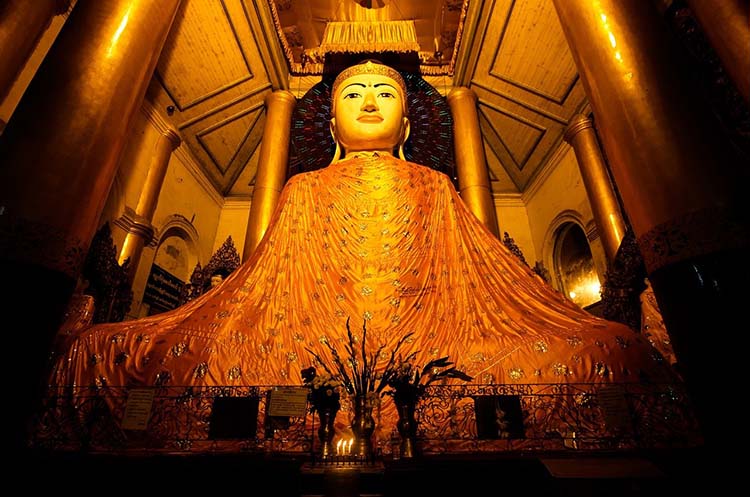
The hair relic of the Buddha
According to legend two Burmese brothers met the Buddha not long after he had reached enlightenment. The Buddha gave the brothers eight of his hairs and told them to enshrine the hair relics on Singuttara Hill, where relics of the three previous Buddhas had already been enshrined. The brothers returned to Burma and gave the Buddha’s hair relics to the King. The spot where the relics of previous Buddhas were enshrined was found. At that spot a relic chamber was built and a pagoda was built over it.
Other structures of the Shwedagon temple
The large temple complex contains many other beautiful and interesting structures. The Naungdawgyi pagoda where only men are allowed to go is the place where according to legend the hair relics of the Buddha were placed before they were enshrined in the main stupa.
A prayer hall contains a 8 meter long Reclining Buddha image.
The Bell Pavilion houses a 23 tons heavy bell cast in the second half of the 18th century. Another pavilion contains a 9 meter high sitting Buddha image wearing a golden robe.
A very attractive pagoda which resembles the Mahabodhi temple in India is decorated with very colorful Buddhist depictions.
The Arakanese Prayer Pavilion has very fine wood carvings, while another pavilion contains murals with scenes from the Jataka tales, the previous lives of the Buddha.
A great number of intricately decorated pavilions with multi tiered roofs called Pyatthat and several Tazaungs, a Burmese temple pavilion enshrining Buddha images are dotted around the complex.
While the oldest original structure of the Shwedagon is what is within the main stupa, the oldest dated structure is the Dhammazedi inscription. This tablet written in Burmese, Mon and ancient Pali language on the pagoda platform dated 1485 contains information about the history of the Golden pagoda.
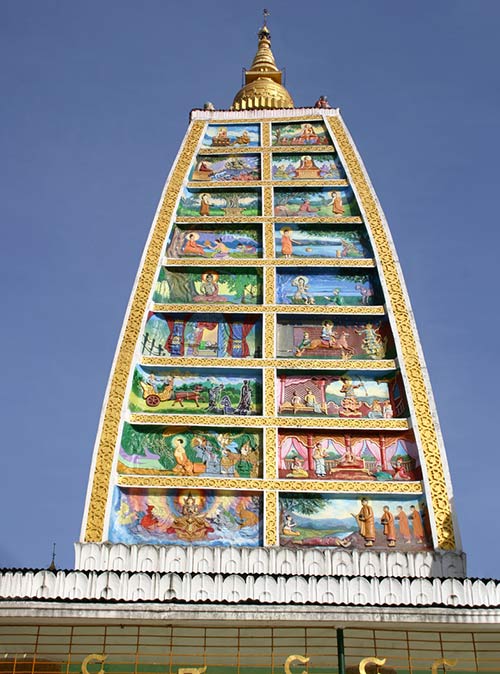
The world’s largest bell
Dhammazedi, King of the Pegu Kingdom during the end of the 15th century had an enormous bell cast in the year 1484. The bell, that is believed the largest bell ever cast weighing almost 300 tons was installed in the Shwedagon pagoda.
In 1608 a Portuguese named Philip de Brito e Nicote who ruled Syriam (present day Thanlyin) as a Portuguese colony stole the Great Bell as he wanted to melt it down to produce cannons. The raft carrying the bell however sunk in the Yangon river. The bell is still at the bottom of the river today.
How to get to the Shwedagon pagoda
The Shwedagon pagoda is located in downtown Yangon on Shwedagon pagoda Road on Singuttara Hill, Dagon township, just West of Kandawgyi Lake. A taxi from the downtown are to the pagoda should cost some US$ 3 - 4. Agree on the price first, often the meter will not be used.
Opening hours
The temple is open daily from 6 am until 10 pm.
Please dress respectfully meaning no revealing clothes, no shorts. Longyis (long cloth worn by Burmese men) are available at the ticket booth. Before entering the temple grounds, please remove shoes and socks. Leave them at the entrance or carry them with you in a plastic bag.
The grounds can get very busy, especially during weekends and Buddhist holidays.
Entrance fee
Admission is US$ 5 per person. A guide for a couple of hours will cost about US$ 5 - 10.
Also in Yangon:
